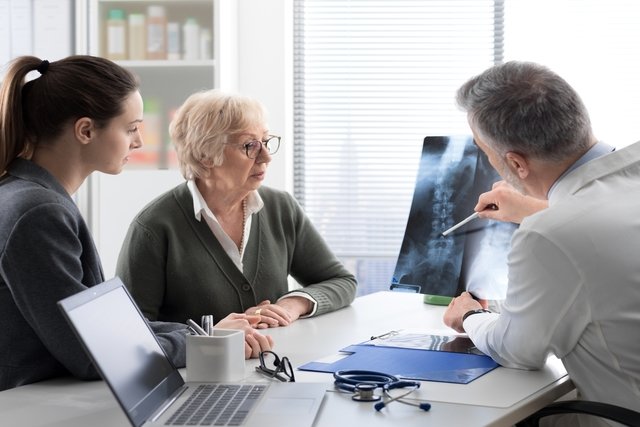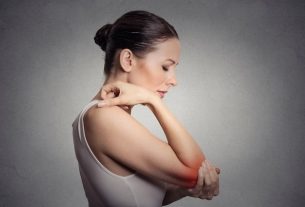Osteoporosis is a disease caused by a decrease in bone mass, making bones more fragile and thus increasing the risk of fractures in the spine, arm, hip or femur, which is the thigh bone.
Being a silent disease, osteoporosis generally does not cause symptoms. However, as the bones become weakened, some fractures can occur causing symptoms such as back pain, hunched posture and decreased height. Know how to recognize some symptoms of osteoporosis.
Although osteoporosis has no cure, treatment aims to improve the person’s quality of life and reduce the risk of fractures, and may include physical exercise and the use of supplements and medications that help improve calcium reabsorption and form mass. bone.

Osteoporosis symptoms
The main symptoms of osteoporosis are:
- Back pain;
- Decrease of at least 2 cm in height;
- Tingling in the legs;
- Hunched posture.
Osteoporosis is a silent disease that does not cause symptoms most of the time. Therefore, the disease is usually identified through examinations carried out after fractures, for example.
How to confirm the diagnosis
The diagnosis of osteoporosis is made by the orthopedist, through the evaluation of the symptoms and signs presented and the family and person’s health history.
In addition, the doctor may also order blood tests to complement the diagnosis, such as a complete blood count, calcium and vitamin D levels, as well as bone densitometry, which is an imaging test that evaluates bone mass. See how bone densitometry is performed.
Make an appointment with your nearest doctor, using the following tool, to assess your risk of osteoporosis and thus initiate the best treatment, if necessary:
Taking care of your health has never been easier!
Main causes
Osteoporosis is caused by a decrease in bone mass, making bones more fragile. It is closely related to the aging of bone cells and can occur mainly in men and women after the age of 50.
Other causes that can also favor the development of osteoporosis are:
- Endocrine diseases, such as diabetes or hyperparathyroidism;
- Calcium and/or vitamin D deficiency;
- Sedentary lifestyle;
- Menopause;
- Inadequate nutrition;
- Smoking;
- Anorexia nervosa;
- Alcoholism;
- Use of some types of medicines;
- Deficiency in hormone production.
In addition, some diseases can also increase the risk of developing osteoporosis, such as cancer, HIV, rheumatoid arthritis, hemophilia, kidney failure and thalassemia.
Difference Between Osteopenia and Osteoporosis
Osteopenia is an imbalance in bone renewal that causes the gradual loss of bone density and which, when identified in the initial phase, can be treated, thus preventing osteoporosis.
Osteoporosis is a disease where there is already a high loss of bone mass, making bones more fragile and thus increasing the risk of fractures.
Read too: Osteopenia: what it is, symptoms, causes and treatment
How the treatment is carried out
Treatment for osteoporosis must be carried out under the guidance of an orthopedist, or general practitioner, and aims to reduce pain, improve the person’s quality of life, and reduce the risk of fractures and complications.
Osteoporosis treatment may include:
1. Medicines
The remedies recommended by the doctor vary according to the causes of osteoporosis, the person’s age, sex and general health, and may be indicated:
- Bisphosphonates, such as alendronate and risedronate, medicines that help maintain bone density, avoiding the risk of fractures;
- Monoclonal antibodies, such as denosumab and romosozumab, medications that are mainly indicated for postmenopausal women and men at high risk of fractures, or when other treatments have not been effective;
In addition, the doctor may also recommend the use of teriparatide, which is a medication indicated for the treatment of osteoporosis in postmenopausal women and men at high risk of fractures.
2. Hormone replacement
Hormone replacement with estrogen may be indicated mainly for menopausal women, to prevent loss of bone mass and fractures. Hormone replacement with testosterone may be indicated for men who, in addition to osteoporosis, also have low levels of this hormone in the body.
3. Supplements
Some supplements, such as calcium, magnesium and vitamin D, may also be recommended by your doctor to maintain bone health.
However, these supplements are generally recommended in cases of low intake of source foods or in situations that reduce nutrient absorption, such as bariatric surgery, celiac disease and Crohn’s disease.
4. Healthy and varied diet
Maintaining a healthy and adequate diet, including foods rich in calcium and vitamin D, such as milk, yogurt, broccoli and almonds, is essential to increase the absorption of calcium and phosphorus, improving bone health.
It is also important to avoid foods that reduce calcium absorption, such as coffee, black tea, salt and fast food. See how to follow an osteoporosis diet.
Read too: 34 foods rich in calcium
5. Physical exercises
Practicing physical exercise regularly, such as walking, dancing and water aerobics, helps to strengthen muscles and joints, preventing fractures and relieving the symptoms of osteoporosis. Discover some exercises recommended for those with osteoporosis.
How to prevent
Osteoporosis prevention must be done throughout life, from the beginning in childhood through the adoption of simple habits, such as:
- Maintain a healthy and varied dietconsuming foods rich in calcium and vitamin D, such as dairy products, eggs and fatty fish, because these nutrients are essential for the formation of bones;
- Get 15 to 30 minutes of sunlight a day, to facilitate the production of vitamin D by the body, since this vitamin participates in the process of calcium absorption in the body. See how to sunbathe to produce vitamin D in the body;
- Practice physical exercisessuch as walking, running and weight training, as they help to strengthen muscles and joints, improving bone density;
- Avoid cigarettesas smoking is associated with an increased risk of osteoporosis;
- Decrease consumption of alcoholic beveragessince alcohol consumption is related to a decrease in calcium in the body.
In the case of elderly people, it is important to keep the house safe to avoid falls and reduce the risk of fractures. Therefore, it is recommended to avoid carpets in the home and bathroom, install non-slip floors and protective bars.
Read too: 8 tips to improve calcium absorption
Check out the video below for more tips on how to have stronger bones and reduce the risk of osteoporosis:

Sign up for our newsletter and stay up to date with exclusive news
that can transform your routine!
Warning: Undefined array key "title" in /home/storelat/public_html/wp-content/plugins/link-whisper-premium/templates/frontend/related-posts.php on line 12
Warning: Undefined array key "title_tag" in /home/storelat/public_html/wp-content/plugins/link-whisper-premium/templates/frontend/related-posts.php on line 13



